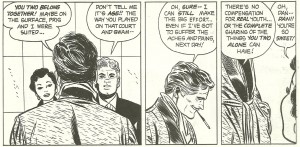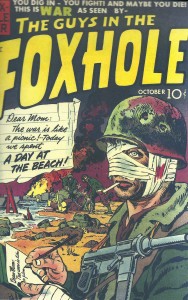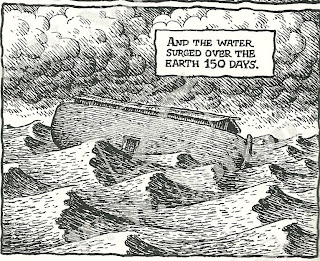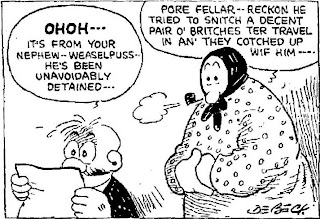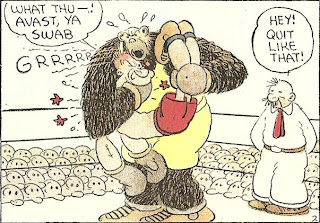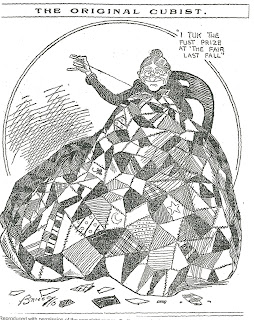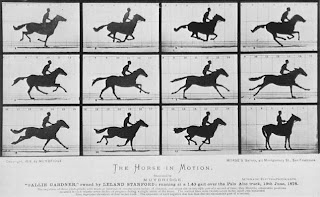
Eadweard Muybridge’s motion study of a galloping horse.
This is the first of a new series of blog posts I’m going to be starting up under the umbrella title “Research Notes.” These posts will be quick notes on ideas that could (and maybe should) be spun off into larger, more polished essays. But in the research note I’ll just jot down the preliminary notion. Since Comics Comics has a very smart and articulate readership, my hope is that the notes will spark suggestions for how the idea can be refined and developed.
So the first research note is for an essay on “Comics and photography”; the idea was sparked by Dan’s earlier comments on the new Rip Kirby book (and by a subsequent conversation Dan and I had). Some quick thoughts:
Comics and photography were both part of the proliferation of images that occurred in the 19th century, the explosion of the visual made possible by mechanical reproduction.
To what extent were late 19th and early 20th century cartoonists like A.B. Frost and Winsor McCay, who did so much to introduce sequential movement into comics, influenced by the motion studies of Eadweard Muybridge?
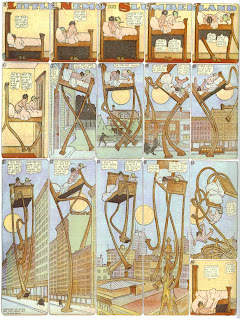
Winsor McCay’s motion study of a galloping bed.
Frank King was a lifelong shutterbug, at the vanguard of the first generation of middle-class Americans who used the camera to record family life. As Chris Ware and I have documented in the Walt and Skeezix series, photographs were a major source for King, who used family photos as a reference tool. Yet King only very rarely directly copied from photos; rather he used photos as a memory tool. And indeed, even King’s own photos seem somehow not to record so much a moment in time as a slightly-fuzzy memory of a moment. King’s photos are nostalgic and backward looking.
The Sickles/Caniff school is often linked to movies, and it’s true that Sickles and Caniff were great film buffs and absorbed much from the cinema of the 1930s and 1940s, not just classics like Citizen Kane but also B-movies with their slightly darkened sets. Caniff and Orson Welles had a mutually admiring correspondent. A fan letter to Caniff in the early 1940s smartly compared Terry and the Pirates to Casablanca. What hasn’t been investigated is the likely impact of magazine photos: the 1930s were the decade Life magazine took off as America’s leading photo-magazine. The use of photographs to record the news, particularly the darker corners of the Depression and the onset of the war, transformed the world’s visual imagination: Walker Evans, Dorothea Lange (who was friends with George Herriman by the way), George Strock, and many others. Caniff was paying attention.
Socially and politically he was very close to many people in the Time/Life staff, who tended to be smart, internationally minded college boys like himself. The Luce magazines often promoted Caniff’s work, since he did the comic strips that most closely resembled their own aesthetic and political outlook.
If Caniff came out of Life, the post-war Alex Raymond was affiliated with Vogue. Depression austerity and wartime rationing were over and Paris was in ruins, so the post-war years were the period when New York became the world’s fashion capital. The first Rip Kirby story involves a fashion model; and the whole ambience of the strip comes from the fashion world. Raymond’s drawings weren’t just done in a photorealist style; they were distilled fashion shots.
If King used photos to pull him back to the past, Raymond was interested in snapshots that caught the present, the sleek and shiny now rather than the blurry bygone days.
Like Caniff, Raymond often photographed models. But when Raymond reinvented his style with Rip Kirby he was able to take this use of models and photos an extra step because of a new invention: the Kodak instant camera. Photorealist comics depended on this new technology.
Even among naturalistic, literal-minded illustrators, not everyone was a fan of photography. Here is Burne Hogarth’s thought: “[Hal Foster] is one of the great geniuses of the comic strip….Other artists were fixated on photographs; this guy worked it out straight out from his eye outward. He solved problems that very few people ever did. I began to realize that because when I had to draw figures that were flying, I sat down and draw those things, for Christ’s sake. I couldn’t have models pose. Milt Caniff many times had model pose. Stan Drake had models pose. The point I’m making is that those guys used Polaroid cameras all the time.” (The Comics Journal, #166, p. 75).
The decline of photorealism as a comics style might have something to do with the parallel decline of magazine photojournalism. During the years when Life was supplanted by television, photorealism lost favour as a cartooning style.
In sum, it’s not just the case that some major cartoonists were influenced by photography. More complexly, as photography evolved, comics followed along; the two art forms developed in tandem.






